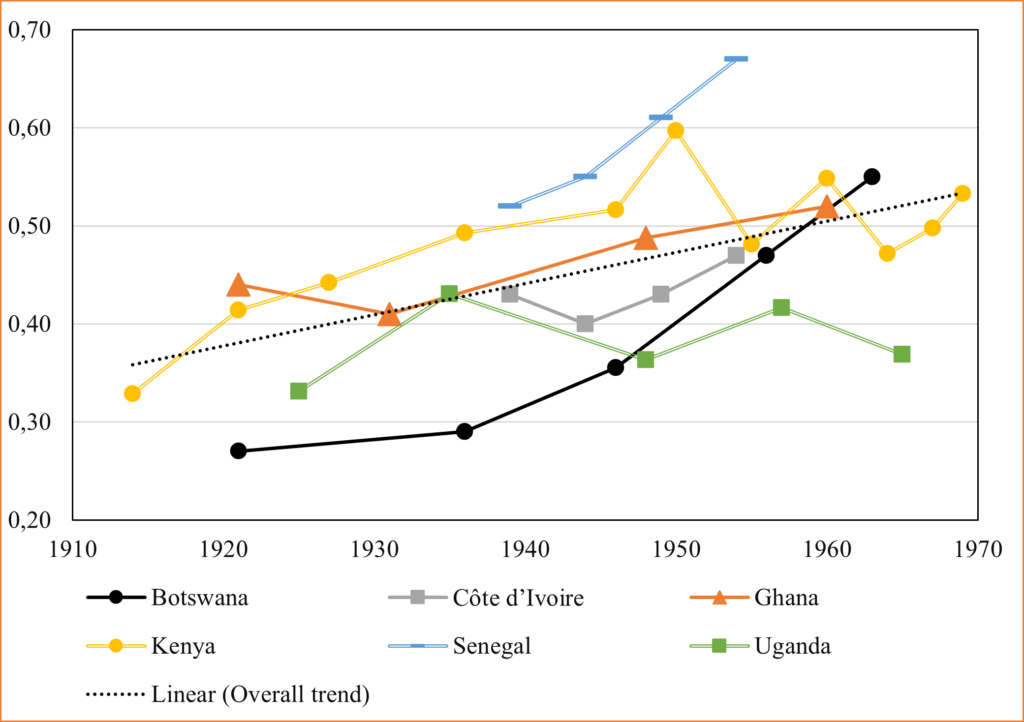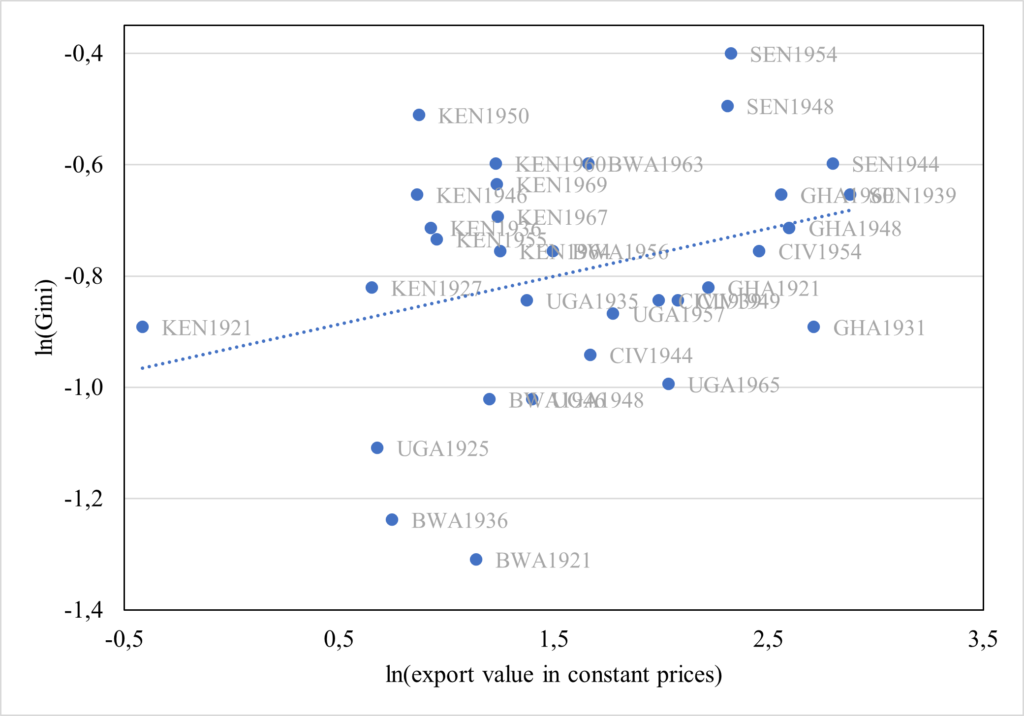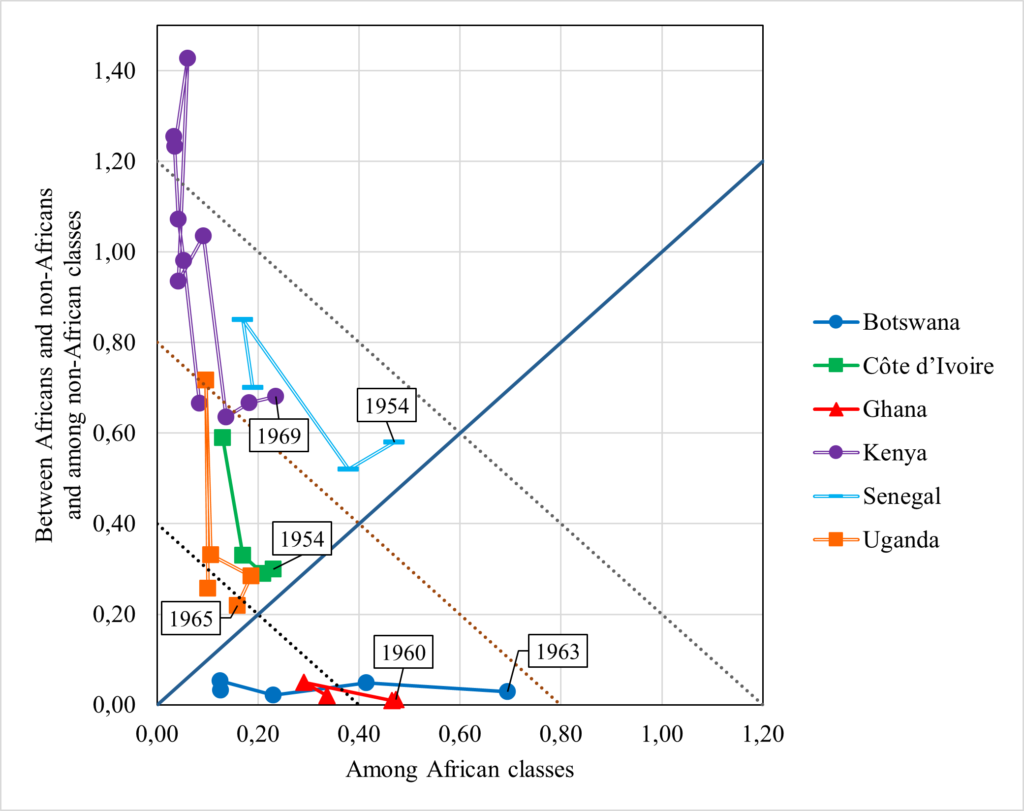Income inequality and export-oriented commercialization in colonial Africa: Evidence from six countries
Today, Africa is characterized by substantial variations in income inequality levels between and within countries. While certain countries in West and North Africa portray a relatively equal distribution of incomes, others, notably in Central, Eastern, and especially Southern Africa, grapple with entrenched inequalities. Scholars have long identified two key historical explanations for the outcomes of African inequality. First, high-income inequality today has been linked to the colonial legacy of a “dual economy”: high wage incomes of expatriate groups and formally employed Africans on the one hand and low (agricultural) incomes for most self-employed Africans on the other (Bigsten 2018; Cogneau et al. 2007). Second, the increasing participation of African colonial economies in international commodity trade and the consequent commercialization of these economies boosted income-earning opportunities in the export sector, benefiting regions, ethnic groups, and social layers unevenly, again with long-term effects. Yet, comparative quantitative research on how colonial rule and European settlement affected economic inequality unevenly across African colonies remains sparse and confined mainly to conjectures about inequality differences between “settler” and “peasant” economies. Moreover, the quantitative study of the concrete and variegated impact of export-oriented commercialization on the nature of African income distributions and levels of inequality remains confined to a few isolated case studies.
In our paper (Hillbom et al. 2023), we investigate a total of 33 social tables in the period 1914 to 1969 to establish how inequality evolved and how it was associated with the expansion of export-oriented commercialization and the presence of European and Asian expatriates and settlers (hereafter referred to as non-Africans). Our sample includes Botswana, Ghana, Côte d’Ivoire, Kenya, Senegal, and Uganda (Aboagye & Bolt, 2021; Alfani & Tadei, 2019; Bigsten, 1987; Bolt & Hillbom, 2016; De Haas, 2022). The advantage of social tables is that they allow for constructing inequality indicators for the full income-earning population in the context of limited data availability. Essentially, social tables simplify a country’s income distribution by identifying a limited number of “social classes” and assuming a uniform income within each class. As social tables capture streams of non-monetized incomes and commercial farming, they inform us about the incomes of both self-employed groups and wage-earners.
The six countries in our study all experienced substantial export-oriented commercialization based primarily, but not exclusively, on various agricultural commodities (cocoa, coffee, cotton, groundnuts, and livestock). Further, they constitute a diversity of economic structures and colonial institutions, including both “peasant” and “settler” economies, with a variation in the prevalence and roles of non-Africans. Even though the countries are selected based on data availability and cannot be treated as representative of sub-Saharan Africa, our sample contains sufficient variation for a comparative analysis of how export-oriented commercialization and expatriate presence affected income inequality in African agrarian societies within different colonial economic structures.
We calculate different measures of economic inequality, each with different characteristics. We use the Gini coefficient (Gini hereafter) as our baseline metric. Compared to other measures such as top income shares, the Gini has a significant advantage in that it is responsive to changes in the middle of the income distribution. We also calculate Inequality Extraction Ratios (IER), which consider that the scope for inequality increases as economies become more prosperous and more “surplus” income is generated beyond basic survival. As such, it provides a more conservative approach to inequality increases in periods of economic growth. Finally, we consider the Theil coefficient (Theil), which is more responsive towards changes at the tails of the income distribution and it is fully decomposable. We decompose the Theil both by race and by sector to explore how inequality was linked to the presence of non-Africans and capital intensity of agricultural commercialization, which drove accumulation and differentiation processes among Africans.
Our findings are as follows. First, during the colonial period of export-led economic expansion, overall inequality increased, but with substantial variation across individual countries. Second, increases in inequality were associated with agricultural commercialization (see Figures 1 and 2 below).


Third, by decomposing inequality by race (see Figure 3), we establish that racial cleavages in the colonies with a larger proportion of expatriates in the population – Kenya and Senegal – accounted for a large proportion of overall inequality. We also observe that inequality among Africans was lower in colonies with a larger proportion of settlers compared to colonies with limited European and Asian settlement. This suggests fewer opportunities existed for Africans to benefit from the export economy when more expatriates were present. These patterns indicate that colonial settlement played a significant role in determining how the incomes from export-oriented commercialization were distributed, echoing experiences in other colonial contexts such as Latin America.

Notes: The diagonal lines (top left to bottom right) are ‘inequality indifference lines.’ Along these lines, the total Theil index is constant. The line separating the top left and bottom right halves of the graph illustrates the decomposition where the ‘expatriate’ and ‘African’ components are equal. All points below this line indicate that inequality among Africans contributed more to the overall Theil index than expatriates and vice versa.
Fourth, by decomposing inequality by sector, we observe substantial inequalities within the agricultural sector, especially in non-settler colonies. (see Figure 4). In these colonies, the varying resource demands of specific agricultural commodities, particularly the capital intensity and potential for capital accumulation, emerged as a significant factor influencing the link between export production and inequality. For instance, annual field crops like cotton, requiring extensive labour with minimal capital investment, offered limited avenues for wealth accumulation and exhibited low returns to labour, restraining the potential for large-scale, plantation-style production and mitigating inequality. Conversely, cultivating tree crops such as coffee and cocoa demanded substantial upfront labour and fixed capital investments, promising higher returns once matured. This incentivized the hiring of external labor, facilitating the development of large-scale plantations and capitalist labour relations, consequently increasing inequality. Moreover, livestock-based commercialization, considered a primary form of capital, further widened income disparities as sustainable income relied heavily on reaching a certain threshold in herd size. Overall, our findings suggest that specialization in capital-intensive commodities was closely linked to heightened inequality in the agricultural sector, particularly towards the end of the period.

Notes: First and last observations by country are indicated. The diagonal lines (top left to bottom right) are ‘inequality indifference lines.’ Along these lines, the total Theil index is constant. The line separating the top left and bottom right halves of the graph illustrates the decomposition where the ‘agricultural’ (within) and ‘non-agricultural’ (within and between) components are equal. All points below this line indicate that inequality among the agricultural classes contributed more to the overall Theil index than the non-agricultural sector, and vice versa.
References
Aboagye, P. and Bolt, J. (2021). Long-Term Trends in Income Inequality: Winners and Losers of Economic Change in Ghana, 1891-1960. Explorations in Economic History, 82: 101405.
Alfani, G. and Tadei, F. (2019). Income Inequality in French West Africa: Building Social Tables for Pre-Independence Senegal and Ivory Coast, UB Economics Working Papers 2019/396.
Bigsten, A. (1987). Income Distribution and Growth in a Dual Economy: Kenya 1914-1976. Gothenburg University, Department of Economics, Memorandum nr 101.
Bigsten, A. (2018). Determinants of the Evolution of Inequality in Africa. Journal of African Economies, 27 (1): 127-148.
Bolt, J. and Hillbom, E. (2016). Long‐term trends in economic inequality: lessons from colonial Botswana, 1921–74. The Economic History Review, 69: 1255-1284.
Cogneau, D., Bossuroy, T., De Vreyer, P., Guenard, C., Hiller, V., Leite, P., Mesple-Somps, S., Pasquier-Doumer, L., and Torelli, C. (2007). Inequalities and Equity in Africa. Agence Francaise de Developpement (AFD).
De Haas, M. (2022). Reconstructing income inequality in a colonial cash crop economy: five social tables for Uganda, 1925-1965. European Review of Economic History, 26 (2): 255-283.
Hillbom, E., Bolt, J., De Haas, M., and Tadei, F. (2023). Income inequality and export‐oriented commercialization in colonial Africa: Evidence from six countries. The Economic History Review.